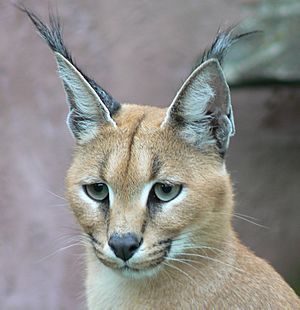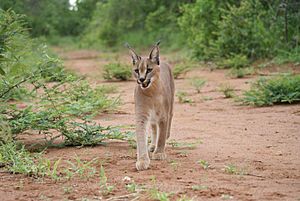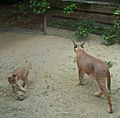Caracal facts for kids
Quick facts for kids Caracal |
|
|---|---|
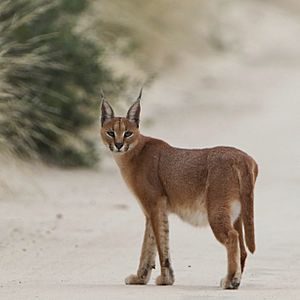 |
|
| Caracal in Kgalagadi Transfrontier Park | |
| Conservation status | |
| Scientific classification | |
| Genus: |
Caracal
|
| Species: |
caracal
|
| Subspecies | |
|
See text |
|
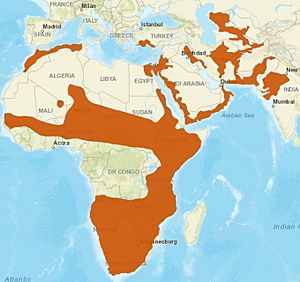 |
|
| Distribution of caracal, 2016 | |
The caracal (Caracal caracal) is a cool, medium-sized wild cat. It lives in parts of Africa, the Middle East, Central Asia, and dry areas of Pakistan and northwestern India. Caracals are known for their amazing hunting skills and unique ear tufts.
Contents
What is a Caracal?
The caracal is a strong cat with long legs and a short face. It has long, tufted ears and long canine teeth. Its fur is usually reddish-tan or sandy in color. A caracal stands about 40 to 50 centimeters (16 to 20 inches) tall at the shoulder. It can weigh between 8 and 19 kilograms (18 to 42 pounds).
Caracals have special black markings on their faces. They have 4.5-centimeter (1.8-inch) long black tufts on their ears. There are also two black stripes from their forehead to their nose. Their mouth is outlined in black, and they have white patches around their eyes and mouth.
Male caracals are usually a bit bigger than females. Males are about 78 to 108 cm (31 to 43 inches) long from head to body. Their tails are 21 to 34 cm (8 to 13 inches) long. Females are 71 to 103 cm (28 to 41 inches) long with tails 18 to 31.5 cm (7 to 12 inches) long.
Where Caracals Live
Caracals live in many places across Africa, especially south of the Sahara desert. They are rare in North Africa. In Asia, you can find them from the Arabian Peninsula and Middle East all the way to western India.
They live in different types of places like forests, savannas, and even semideserts. Caracals like dry areas with little rain and plenty of places to hide. In mountains, like the Ethiopian Highlands, they can live as high as 3,000 meters (9,800 feet) up.
Sometimes, caracals are seen near roads in places like Ethiopia. In the Emirate of Abu Dhabi, a caracal was seen in 2019 for the first time in many years. In Turkey and Iran, caracals live in wildlife areas. In Uzbekistan, they are mostly found in desert regions. In India, caracals live in places like Sariska Tiger Reserve.
Caracal Behavior
Caracals are usually active at night. They are very shy and hard to spot. Most caracals live alone or sometimes in pairs. They mark their territory by spraying urine on rocks and plants. They might also leave their droppings, but they don't cover them up.
Their ear tufts and face markings help them communicate. Caracals have been seen moving their heads side to side, making their ear tufts flicker quickly. Like other cats, caracals can meow, growl, hiss, spit, and purr.
What Caracals Eat and How They Hunt
The caracal is a carnivore, meaning it eats meat. They mostly hunt birds, rodents, and other small mammals. In South Africa, they eat animals like Cape grysbok and Cape hare. Mammals make up most of their diet, usually over 80%. They can even hunt larger animals like young kudu or impala. They also eat lizards, snakes, and insects.
Caracals are amazing hunters. They sneak up on their prey until they are very close, about 5 meters (16 feet) away. Then, they run quickly to catch it. They kill their prey with a bite to the throat or the back of the neck. They usually eat their meal right away. Sometimes, they might eat food that other animals have left behind, but this is not common.
Caracal Families
Both male and female caracals can have babies when they are about one year old. They can breed at any time of the year. The mother caracal is pregnant for about two to three months. She then gives birth to a litter of one to six kittens.
When kittens are born, their eyes and ears are closed. Their claws cannot be pulled back yet. Their fur looks like the adults', but their belly has spots. Their eyes open after about ten days, but it takes longer for them to see clearly. Their ears stand up and their claws can be pulled back by their third or fourth week. Young caracals leave their mothers when they are about nine or ten months old. Caracals in zoos can live for almost 16 years.
Protecting Caracals
The caracal is listed as "Least Concern" by the IUCN Red List. This means they are not in immediate danger of extinction. However, they face threats like losing their homes because of farms, roads, and new buildings. They are thought to be almost gone in North Africa and are in danger in places like Pakistan and Jordan.
People sometimes kill caracals to protect their farm animals, especially small ones. Caracals are also sometimes hunted for the pet trade. In Turkey and Iran, many caracals are killed in road accidents. In Uzbekistan, herders often kill them to protect their livestock.
To help caracals, hunting them is against the law in many countries. These include Afghanistan, India, Iran, and many others. Caracals also live in many protected areas. In South Africa, caracals are doing well because they can live in many different places, even near humans. Farmers there are asked to report any caracal sightings to help with conservation efforts.
Caracals in History and Culture
Caracals were important in ancient Egypt. You can see them in paintings and as bronze statues. Some sculptures of caracals were thought to guard the tombs of pharaohs. Even mummified caracals have been found!
Caracals were also valued for their amazing ability to catch birds in flight. In India, Mughal emperors used caracals for hunting small game. Chinese emperors even received caracals as gifts. In the past, people would bet on which caracal could catch the most pigeons in an arena. This might be where the saying "to put the cat among the pigeons" came from! Their fur was also used to make coats.
Interesting Facts About Caracals
- The caracal was first described by a scientist named Johann Christian Daniel von Schreber in 1776.
- There are three main types, or subspecies, of caracals:
- The southern caracal lives in Southern and East Africa.
- The northern caracal lives in North and West Africa.
- The Asiatic caracal lives in Asia.
- The name 'caracal' comes from a Turkish word meaning 'black ears'.
- Caracals are also called the desert lynx or Persian lynx.
- Even though they have tufted ears like a lynx, caracals don't have spots like lynx do.
- In the Tigrinya language, their name means 'bearded lion'.
- Caracals can jump over 3 meters (10 feet) high to catch birds in midair!
- In Ancient Egypt, caracals were kept as pets by pharaohs. They were treated like royalty!
Images for kids
-
A caracal in the San Diego Zoo
See also
 In Spanish: Caracal para niños
In Spanish: Caracal para niños



